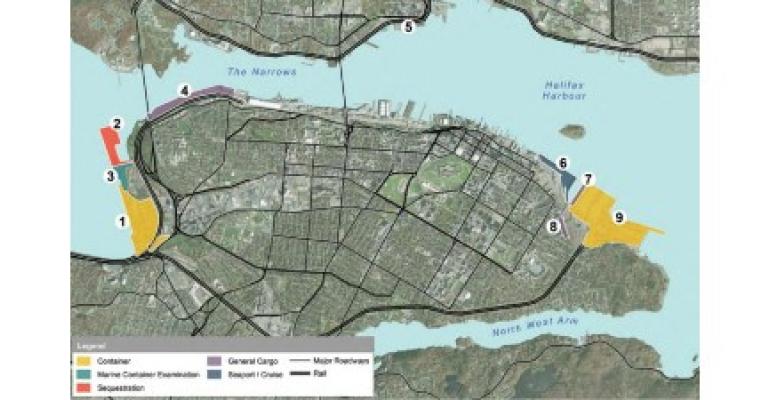The Halifax Port Authority's 50-Year Plan projects cruise traffic to steadily grow to between 1.4m and 2.4m people by 2070. Meanwhile, cruise lines are deploying larger assets, with vessels approaching 350 meters and upwards of 6,000 passengers becoming more common.
Current infrastructure can handle one very big ship
The Port of Halifax’s current primary cruise berths are more than 100 years old. With planning and scheduling, they can handle one vessel this size but additional infrastructure will be needed to service more than one concurrently.
Bermello Ajamil study
Pre-pandemic, Bermello Ajamil & Partners worked with the port authority on a long-term plan that examined eight possible options along the Halifax and Dartmouth waterfronts and concluded Dartmouth could be a preferred location.

Current cruise berths are at 6, while 5 shows the potential location for two Oasis-class berths
Various sites were then identified for further evaluation to berth two Oasis-class vessels simultaneously. Preliminary analysis of this option in partnership with Halifax Regional Municipality and Nova Scotia province began in 2019 but was put on hold during the pandemic. No final decision on a new location or timing for new cruise infrastructure has been made.
Opportunity to spread out traffic, economic benefit
According to the newly released 50-Year Plan, the potential of adding cruise berths at Dartmouth 'creates some very interesting opportunities that warrant further discussion.'
This would 'bring together both sides of the harbor in a way we’ve never seen before. It would also help distribute the people and vehicular traffic associated with cruise more evenly and could create the potential for additional tourism activity and economic benefit on the Dartmouth side as cruise passengers embark on their own self-guided tours and explore the unique offerings found throughout Downtown Dartmouth.'
Community support will be the driving force
The 50-Year Plan also notes this could serve as a catalyst for further development of the Dartmouth waterfront, adding that 'Community support will be the driving force behind any major infrastructure spending in this area.'
Halifax Port Authority will 'continue to engage the community, municipal, provincial and federal partners to ensure the resurgence and future growth of this sector is managed within community expectations and with sustainable growth considerations in mind,' adding: 'The development of cruise on the Dartmouth side of the harbour should be part of a larger Dartmouth Waterfront planning process.'
Halifax is recovering from two years without cruise ships but said confirmed bookings for the 2022 season and beyond are 'strong.'
Optimizing existing assets
Cruise ships have normally visited between April and October, with approximately 70% of the business occurring in the peak months of September and October. Pre-pandemic, the port was increasingly working to accommodate up to five cruise ships at dedicated berths with two large vessels at Piers 20 through 22, one smaller vessel at berths 23 and two additional vessels at Pier A and Pier A1.
Weekly berth utilization from 2015 to 2019 showed Monday and Thursday are the busiest days, with calls tapering off on Saturdays and Sundays. The 50-Year Plan notes that evenly distributing cruise berth utilization combined with more efficient operational planning will contribute to optimizing existing assets before undertaking any large capital expenditures.
More summer traffic desired
This, it adds, will require collaboration with cruise lines and neighboring ports to effectively promote Atlantic Canada’s summertime experience. Optimization will allow future demand to be captured without significant infrastructure spending, but it will not enable the port to berth newer and larger ships.
Tendering a short-term option
As megaships are increasingly common, modernization of the existing assets will be required for future growth, the 50-Year Plan notes, adding that anchoring vessels and tendering may be a short-term option to enable larger ships to call until infrastructure is upgraded.
Copyright © 2024. All rights reserved. Seatrade, a trading name of Informa Markets (UK) Limited.
Add Seatrade Cruise News to your Google News feed.  |

